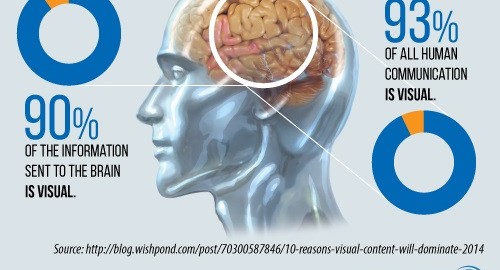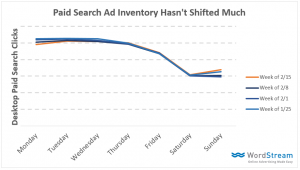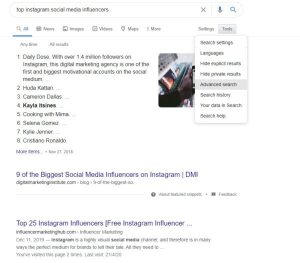We live in a visual world. And although the trends in recent years have swung heavily toward the visual side of marketing, the dominance of visuals in the marketplace is nothing new. Visual marketing is older than cave drawings.
Compelling visuals make the circle of life go round. But why are visuals so powerful? It comes down to the way our brains receive and transmit information. It’s a matter of speed.
The Physiology of Visual Communication
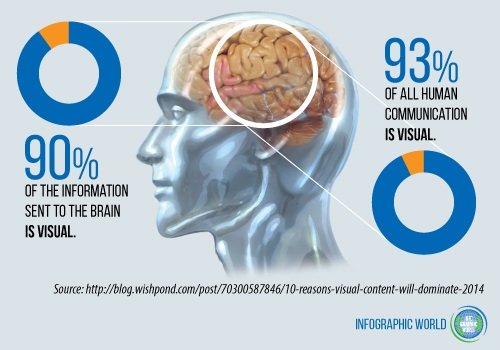
In a race, text just can’t compete with images. It makes sense. After all, we don’t even possess the innate cognitive ability to process words. It’s an entirely more advanced process our brains have to work through. At birth, a baby understands the image of his or her mother months before being able to understand what the word mommy means. We understand images instantly. We have to work to process text.
In fact, the brain processes images 60,000 times faster than it does text. And it’s more accustomed to processing images—ninety percent of the information sent to the brain is visual, and 93% of all human communication is visual. Again, none of this is new or recent. The human brain has always processed images ridiculously faster than words, so . . . the recent trends in marketing shouldn’t be surprising.
Visual Marketing’s Recent Domination Over Textual

There was a time when the Internet was more text than images. Downloading photos took minutes, sometimes hours. More images meant more waiting. Email was text only. Newspapers were mostly news printed on paper. (Go figure, right?)
Fast forward to 2015 and it’s an entirely different story. Pages with images or video draw, on average, 94% more views than their text-only counterparts. Landing pages with video (which were a complete nonfactor online 20 years ago) convert customers 86% more frequently than those with boring old words and motionless images. And email? 65% of email readers prefer messages that are mostly images.
The balance of digital marketing has completely shifted to favor visual over textual content. We’ve already discussed that the preference for visual communication has always existed, so why is it suddenly dominating the way it is? The answer is speed.
Visual Velocity: Constantly Mobile
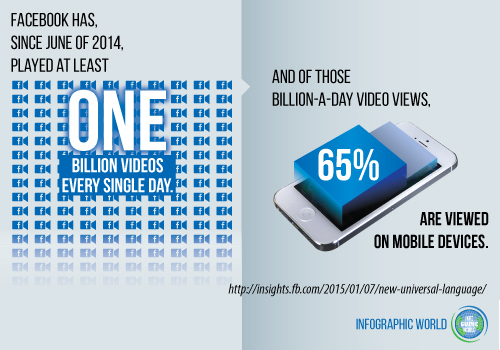
The love of images is as old as humanity itself, but the need for speed is a much more recent development, at least at the speeds humans are able to communicate in 2015. Technology is catching up with the brain’s ability to process image . . . or the human attention span is dwindling to gnat-like levels. Either way, the task of the modern marketer is to communicate loads of information in a blink. And it’s important to consider how the market consumes its information: on the go.
Few people sit down to a computer anymore. Smartphones and tablets are the new desktop and laptop. It’s becoming less and less of a stretch to say that everyone has a high-powered mobile device, because 80% of adults worldwide own a smartphone. And the degree to which we use our smartphones is astronomical. The smartphone is built for visuals, and nowhere is that more obvious than on Facebook.
Facebook has, since June of 2014, played at least one billion videos every single day. And of those billion-a-day video views, 65% are viewed on mobile devices. Think people use their phones mostly for texting? Think again. Of all time spent in the U.S. consuming digital media—not just on smartphones but digital media in any form—over half of that time was spent on mobile apps. That’s mostly due to the fact that 65% of all digital media time is spent on mobile devices—and we’re obviously doing more app usage than texting.
And how does this all lead to visual marketing? Aside from the fact that every minute we spend staring at a screen (over 7 hours a day, on average in the U.S.) is an opportunity for visual marketing, the time spent on smartphones represents the bulk of it, mostly on apps. And the fastest growing type of app? Shopping apps. They grew by 174% in 2014 compared to the previous year. That’s right, mobile consumers are no longer gravitating toward games and entertainment on their apps nearly as much as they’re shifting to taking real-life action through their mobile devices.
The Takeaway
We’ve seen how visual communication takes place at lightning speed in the human brain. We know that the most effective marketing is visual in nature in part because of the speed at which consumers skim from one activity to the next on the rapid-fire smartphone/tablet landscape. Americans spend almost a third of every day staring at screens, and none so often as the ones they hold in the palms of their hands. We want images, videos, and inordinate amount of information that requires very small amounts of our attention. And in the midst of it all, we are actively spending money without even looking up from our phones.
Visual marketing isn’t just a growing force in marketing. It’s becoming the very essence of the way businesses connect with their customers.
(513)
Report Post